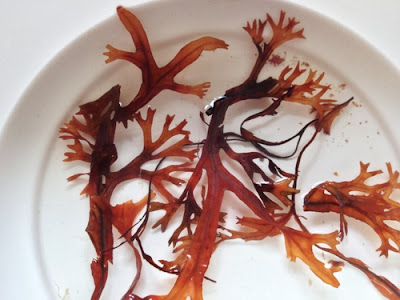 |
| Seaweeds on the beach at West Bay in Dorset, UK www.cookingforhealth.biz |
Ten years ago it had never occurred to me to eat seaweed.
Just the thought of it made my nose wrinkle up.
Then I met Montse Bradford, a leading authority on healing with whole foods. After two years of training with Montse, I became a passionate advocate of the health benefits of eating seaweed.
In Britain, we live on islands surrounded by sea, yet seaweed is not central to the British diet as it is in Japan.
The Japanese use over 20 species of seaweed in their every day cooking and a number of species are commercially farmed.
 |
| Sushi nori |
Apart from a few celebrity chefs and people who have been on courses like mine, few people in the UK even think of eating seaweed.
Despite the fact that UK waters hold about 630 species of seaweed, about 35 of which are palatable enough to eat, most seaweed eaten in the UK is imported from Asia.
Indeed, most references to seaweeds in the English language use their Asian names, such as nori and wakame, instead of their native names, such as kelp, dulse, laver and sea lettuce.
 |
| Japanese seaweed products sold in the UK |
Ireland has a thriving seaweed industry, which according to the Irish Fishery Board, is worth €18m (£14.7m) a year.
Most of the Irish seaweed is however grown for speciality products including food additives and cosmetics, as well as "low value" products such as animal feeds, agricultural products, plant supplements and specialist fertilisers.
In Ireland seaweed is associated with poverty, making it a hard product to sell as a whole food to the mainstream.
If you are interested in gathering seaweed from your local beach rather than buying Asian seaweed from the supermarket or health food store, this is what you need to do:
1. Make sure the beach is clean and there are no sewage effluent pipes in the vicinity
In the UK, the Environment Agency is responsible for monitoring the cleanliness and safety of sea water. You can check the results for your beach on their website.
In the US, the Natural Resources Defense Council reports information on water quality of beaches.
If you live in another country, you will have to search the internet to check your local arrangements for water quality monitoring.
2. Check that you have permission to pick the seaweed
Every country has different rules, so you need to check and obtain permission if necessary.
In the UK, commercial gathering of seaweed requires a licence and there is no common law right to pick them (unless they are already detached).
In practice, gathering a small amount for your own use is unlikely to get you into trouble but it is always advisable to ask whoever owns the beach first - it could be the local council, the National Trust or a private owner.
3. Check the tide times
The best time to gather seaweed is at low tide.
Tide timetables are available in local newspapers, on the internet and/or in printed booklets in local shops.
In the USA, the National Oceanic and Atmospheric Administration publishes tide times.
4. Identify which species are present
Check marine algae identification guides for your country and region.
There are a few tropical species which are poisonous but the vast majority of seaweeds are safe to eat.
Some seaweeds are more palatable than others and the species commonly used for culinary purposes tend to be selected for their taste and ease of preparation.
All of the seaweeds in British waters are safe to eat but only a few of the 630 species available tend to be used in cooking:
- dulse - dillisk - Palmaria palmata
- carrageen - Irish moss - Chondrus crispus
- sea lettuce - Ulva lactuca
- laver - sloke - nori - Porphyra umbilicalis
- kelp - oarweed - tangle - kombu - Laminaria digitata
- sugarwrack - sugarkelp - Laminaria saccharina
- dabberlocks - wakame - Alaria esculenta
- pepper dulse - Laurencia pinnatifida
- bladderwrack - fucus - Fucus vesiculosus
Two good sources of information on seaweeds are The Seaweed Site for a general overview, and AlgaeBase which has a wealth of technical detail about seaweeds of all types.
5. Cut the seaweed with scissors or a pen knife, don't pull it off.
Seaweed doesn't have roots as such but it has a 'holdfast' that fixes it onto rocks. If you remove the holdfast, the seaweed loses its ability to regenerate.
 |
| Seaweed holdfast Photo: Heiko Hübscher |
6. Only pick what you need
In order to ensure conservation of seaweeds, just take a little here and there.
You only need small quantities for cooking so there is no need to gather sackfuls.
7. Wash thoroughly in fresh water to remove sand and sea life
8. Spread the seaweed out in the sun to dry, or on a towel in a warm dry place such as an airing cupboard.
Seaweed dries down to about 20 per cent of its fresh weight, so multiply by 5 when converting dry to fresh weight.
9. Dried seaweed should be soaked in fresh water before being used in recipes
Information about how to use seaweed in cooking will be covered in later blogs, so please subscribe to this blog if you wish to find out more.
If you have enjoyed this post, please sign up for my newsletter to keep informed of new information, recipes and courses and visit my website.




No comments:
Post a Comment